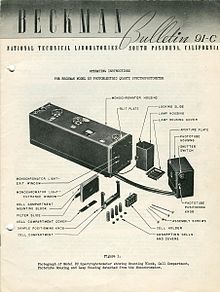
The DU spectrophotometer or Beckman DU, introduced in 1941, was the first commercially viable scientific instrument for measuring the amount of ultraviolet light absorbed by a substance. This model of spectrophotometer enabled scientists to easily examine and identify a given substance based on its absorption spectrum, the pattern of light absorbed at different wavelengths. Arnold O. Beckman's National Technical Laboratories (later Beckman Instruments) developed three in-house prototype models (A, B, C) and one limited distribution model (D) before moving to full commercial production with the DU. Approximately 30,000 DU spectrophotometers were manufactured and sold between 1941 and 1976.
Sometimes referred to as a UV–Vis spectrophotometer because it measured both the ultraviolet (UV) and visible spectra, the DU spectrophotometer is credited as being a truly revolutionary technology. It yielded more accurate results than previous methods for determining the chemical composition of a complex substance, and substantially reduced the time needed for an accurate analysis from weeks or hours to minutes. The Beckman DU was essential to several critical secret research projects during World War II, including the development of penicillin and synthetic rubber.
© MMXXIII Rich X Search. We shall prevail. All rights reserved. Rich X Search
